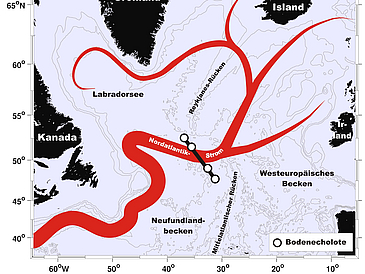The North Atlantic Current (NAC) is a direct continuation of the Gulf Stream and exerts a major influence on our mild European climate. It is often said that the NAC is getting weaker and that temperatures in Europe will cool down as a result. Researchers at the University of Bremen have been trying to find out if this is really true. Their finding: At the moment it is not possible to detect any trend resulting from fluctuations in the transport of warm water in the North Atlantic.
Professor Monika Rhein and her team at the Institute for Environmental Physics and the Center for Marine Environmental Sciences (MARUM) have scored a first: They have compiled a 21-year continuous time series depicting the strength of the North Atlantic Current where it streams from the West into the East Atlantic. The research results have now been published in the world-renowned ‘Journal of Geophysical Research’. “This is the first study that delivers details of long-term transport fluctuations from the open North Atlantic”, says the Bremen environmental physicist Monika Rhein. It was made possible by the deployment of sonar depth sounders that in the course of several years have been anchored in a North-South line along the Mid-Atlantic Ridge. “The measurements we took show that where it flows into the East Atlantic the NAC is just half as strong as the Gulf Stream in the Florida Straits”, explains Dr. Achim Roessler, lead author of the study, “but over a period of four to nine years it is not at all unusual for its strength to vary by as much as 30% or more”. Partly responsible for this are the atmospheric conditions over the North Atlantic, the so-called North Atlantic oscillation.
The NAC is the most important ocean current in the North Atlantic. It transports warm and salt-rich water masses from the sub-tropical regions into our northern latitudes. The warmth it brings with it is distributed far into the North Atlantic before eventually being absorbed into the atmosphere. Until now little was known about the strength of NAC transport and on what time scales fluctuations are produced.
The anchored depth sounders continually transmit acoustic signals and measure the time it takes for these signals to reach the seabed and return to the surface. Taking into account the effect of water pressure, temperature, and salt content on the acoustic velocity, it is then possible to calculate the transport of water masses. In the new study, the data gathered over a four-year period could be extended to 21 years based on satellite observations of water movements on the ocean surface.
At the present time the Bremen research group is on board the German research vessel ‘Maria S. Merian’ somewhere in the sub-polar North Atlantic. Within the scope of expedition MSM-43 they will evaluate the latest data and anchor additional sonar devices.
Publication: Roessler, A., M. Rhein, D. Kieke, and C. Mertens (2015), Long-term observations of North Atlantic Current transport at the gateway between western and eastern Atlantic, J. Geophys. Res., 120
If you would like to have more information on this topic, please contact:
University of Bremen
Faculty of Physics/Electrical Engineering
Institute for Environmantal Physics
Prof.Dr. Monika Rhein
Phone: +49 421 218 62160
mrheinprotect me ?!physik.uni-bremenprotect me ?!.de
http://www.ocean.uni-bremen.de

